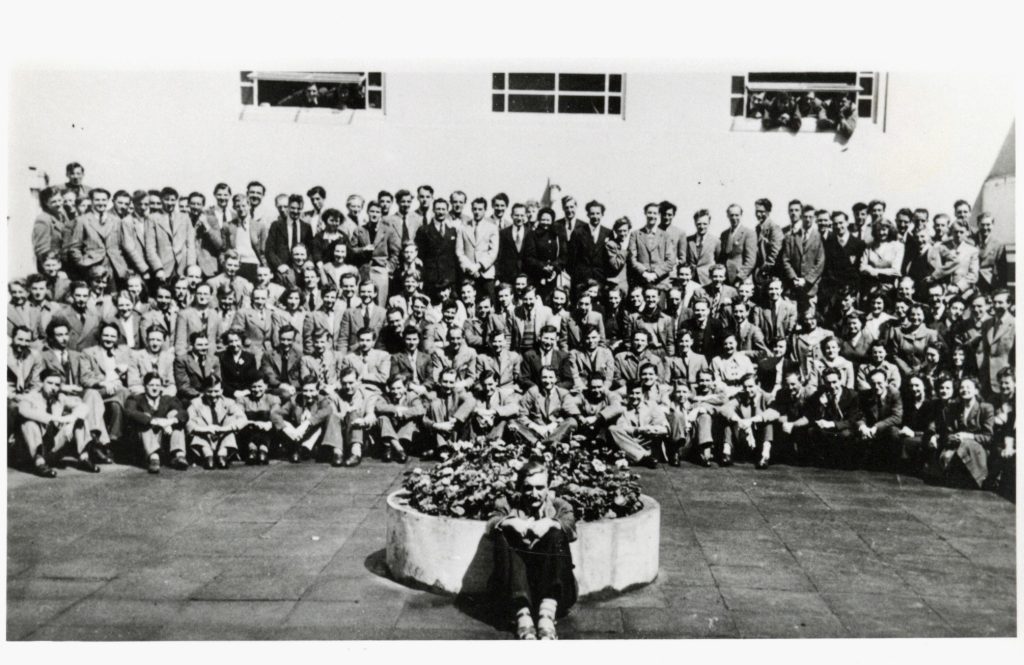A University with a rich history like Liverpool has remarkable stories to tell not only through its archival documents, but also browsing among old books in the Library. Research on one of its most famous post WW2 alumni, James Stirling (1924 − 1992), brought to light a fascinating anecdote ‘discovered’ on the shelves of the Sydney Jones Library.

The son of a ship’s engineer, Stirling moved with his family to Merseyside in 1927, attending Quarry Bank High School, which also counted John Lennon amongst its former students; he proceeded to study at the University of Liverpool School of Architecture (LSA), graduating in 1950. Active since 1894, the LSA is the the oldest full time day school of architecture in the United Kingdom. It gained an international reputation under the leadership of Charles Reilly (1874 − 1948) before and after WW1, and it was enhanced by the intellectual relationships forged with the Polish School of Architecture when decamped on Merseyside during WW2. Influential tutors such as Colin Rowe – who had completed his MA with Rudolf Wittkower in London at the Warburg Institute, in 1947 – exemplify the quality of the learning environment at that time. The vibrant maritime city offered Stirling an eclectic education and vivid interactions: many of the personal relationships which influenced him were built during his time in Liverpool and visibly recurred throughout his life. Liverpool’s humour and cultural richness certainly informed his subsequent personal and professional development. Stirling later recalled aspects of his education in School, as recorded by Mark Girouard in his biography on the architect. Girouard writes that, in a 1984 letter to a correspondent, Stirling listed eight publications, some fully detailed, some less, accompanied by the annotation, “books which influenced me most when I was a student at architecture school. All of the following were of equal importance to me – but if I had to give an order of priority they might be as follows:
Saxl and Wittkower’s British Art and the Mediterranean (1948)
Le Corbusier’s Towards a New Architecture (1927)
A.E. Richardson’s Monumental Classic Architecture in Britain and Ireland (1914) Sartoris’s Architecture Nouvelle
Volumes 1 and 2 of Corbusier’s Oeuvre Complète
Gunnar Asplund Arkitekt (Stockholm, 1943)
Roth’s New Architecture”
We can discern a conjunction of interests, for example, stemming from Rowe, who would have informed his aspiring student of the exhibition British Art and the Mediterranean, which travelled in Britain between 1942 and 1944. The visual anthology of that exhibition, published in 1948 by Fritz Saxl and Rowe’s supervisor Rudolf Wittkower, was a limited edition book and remains on the shelves of the University Library to this day, alongside many others in the list. Years later Stirling, with the fundamental contribution of Léon Krier, modelled his own monograph on Le Corbusier’s Oeuvre Complète (Complete Works), borrowing the format and the logical structure from the French architect’s series of books.
Though this may not be the place to comment in detail about the content of the publications we should acknowledge that, even at a first glance, these volumes have an extremely varied nature, with subjects divided between traditional, classical and avant-garde architecture – an eclectic variety that will be mirrored in Stirling’s architectural career.
In addition to a travelling exhibition on the work of the office, to celebrate the centenary of Stirling’s birth in April 1924 the existing books which were available to him as a student at Liverpool have now been stored in the Special Collections, still accessible to the public but in a way that safeguards their integrity. They now form a set that represents the bulk of the education of an architect who became the most influential British practictioner of the second half of the 20th century – the author with his office and colleagues of masterpieces like the University of Leicester Engineering Building (1959-63) and the Neue Staatsgalerie in Stuttgart (1977-84); and, on the docks in Liverpool, the Tate of the North (1984−1988). The Stirling Prize for the UK’s best new building, awarded each year by the Royal Institute of British Architects, is named after him.
Marco Iuliano with Katy Hooper
References:
Alan Berman, ‘Doodles: an exhibition of the drawings of Stirling, Wilford & Associates, 1984 − 2000’, arq: Architectural Research Quarterly , vol. 26/2, 2022, pp. 124-129.
Mark Girouard, Big Jim: the life and works of James Stirling, London: Chatto & Windus, 1998, p. 37.
Marco Iuliano, Francesca Serrazzanetti (eds.), James Stirling. Inspiration and Process in Architecture, Milan: Moleskine, 2015.
Peter Richmond, Iain Jackson, ‘Designs on Victory: The Polish School of Architecture in Liverpool’, Liverpool History Journal, n. 22, 2023, pp. 80-94.
James Stirling, Buildings & Projects 1950 − 1974, New York: Oxford University Press; London: Thames & Hudson, 1975.